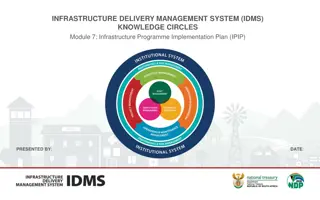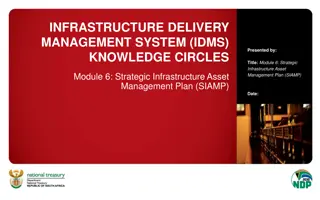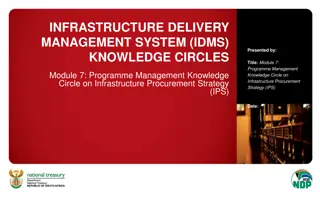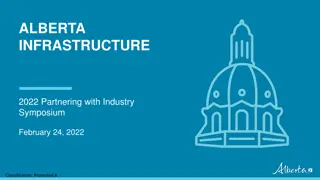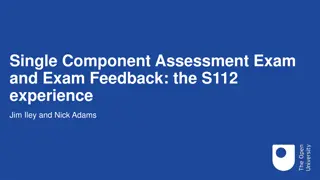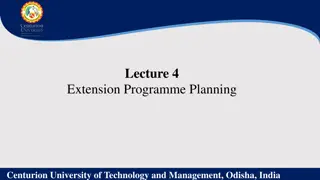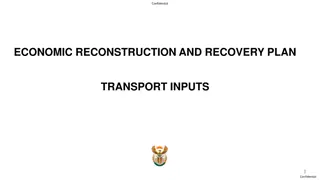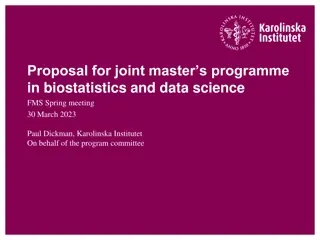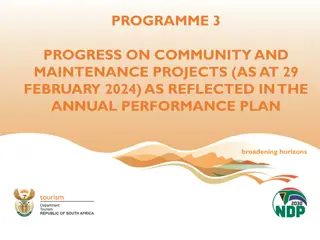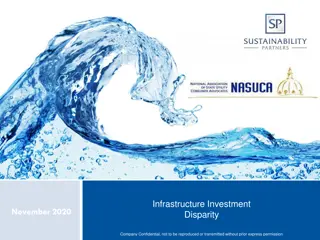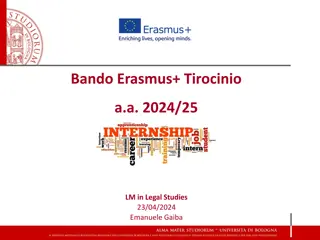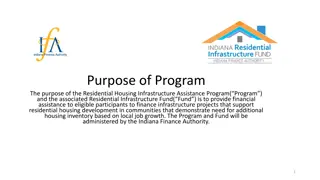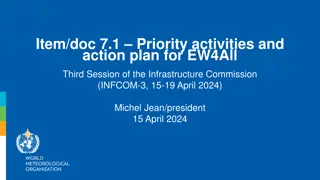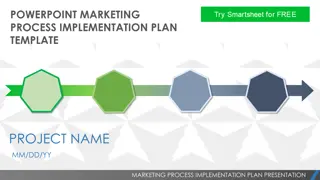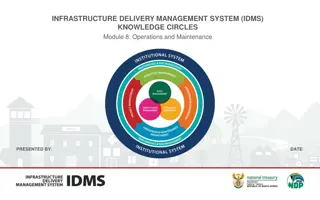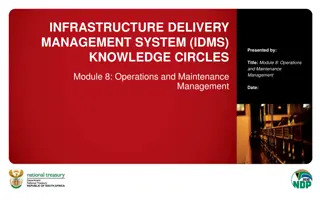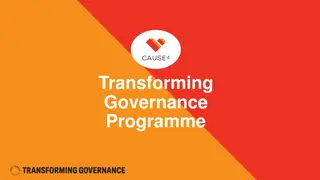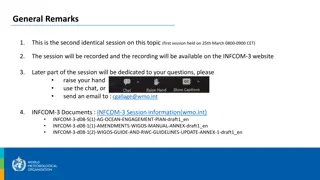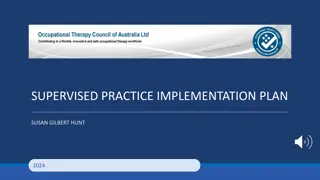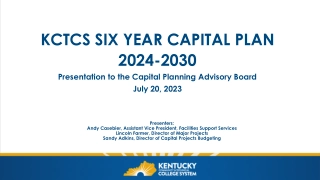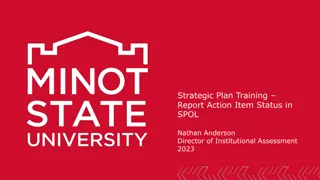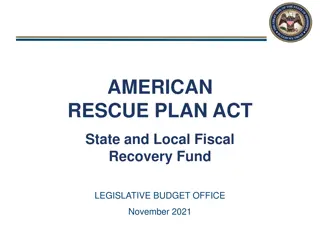Infrastructure Programme Implementation Plan (IPIP) - Module 7 Overview
"Module 7 of the Infrastructure Delivery Management System (IDMS) focuses on the Infrastructure Programme Implementation Plan (IPIP). It provides guidance to programme managers on applying management principles for effective planning and management of infrastructure projects. The module emphasizes synergy with other management modules to ensure sustained performance of infrastructure assets for public service delivery."
- Infrastructure Management
- Programme Implementation
- IDMS Knowledge Circles
- Programme Managers
- Infrastructure Projects
Download Presentation

Please find below an Image/Link to download the presentation.
The content on the website is provided AS IS for your information and personal use only. It may not be sold, licensed, or shared on other websites without obtaining consent from the author. Download presentation by click this link. If you encounter any issues during the download, it is possible that the publisher has removed the file from their server.
E N D
Presentation Transcript
INFRASTRUCTURE DELIVERY MANAGEMENT SYSTEM (IDMS) KNOWLEDGE CIRCLES Presented by: Title: Module 7: Infrastructure Programme Implementation Plan (IPIP) Module 7: Infrastructure Programme Implementation Plan (IPIP) Date:
INFRASTRUCTURE DELIVERY MANAGEMENT SYSTEM (IDMS) KNOWLEDGE CIRCLES Module 7: Infrastructure Programme Implementation Plan (IPIP) PRESENTED BY: DATE:
MODULE 7 Programme Management (Version 5.0) 3
Purpose of Module 7: Programme Management To provide programme manager(s) with guidance to enable them to apply programme management principles, together with the relevant subject matter material pertaining to infrastructure delivery management, to plan and manage their respective programmes of work. It is important to note that the application of programme management on its own is not sufficient to plan and implement the work required to sustain the performance of infrastructure assets needed for public service delivery. It is reliant on working in synergy with the other three infrastructure delivery management modules of Portfolio Management, Operations and Maintenance Management and Project Management. 4
Purpose of Module 7: Programme Management Module 7 is reliant on working in synergy with the other three infrastructure delivery management modules of Portfolio Management, Operations and Maintenance Management and Project Management. MODULE 6 Portfolio Management Process MODULE 7 Programme Management Process MODULE 8 Operations & Maintenance Management Process MODULE 9 Project Management Process & Project Lifecycle 5
Table of Contents 1 Executive Summary 2 Background 3 Infrastructure Programme 4 Infrastructure Budget Estimates Sub-Programme 5 Infrastructure Procurement Direction 6 Strategies to Achieve Effectiveness and Efficiencies and VFM 7 State of Readiness 8 Programme / Projects Performance Trail 9 Improvement Plan 10 Annexures 6
1. Executive Summary The executive summary should give an overview of the following: Summarise and emphasise key issues contained in the body of the IPIP and provide readers with a concise overview on the entire IPIP. Brief description of the institution s strategic objectives and the institution s infrastructure objectives as outlined in the IAM policy, SIAMP and IAMP. Brief outline of the targeted approach towards the attainment of the infrastructure objectives. Outline programme budget allocation (i.e., Operations, Maintenance & Repairs, Upgrades & Additions, Rehabilitation & Refurbishments, New Infrastructure Assets and Disposal). 7
2. Background This section must: Provide background to the applicability of the previous year s IPIP version(s), where relevant. Demonstrate an understanding of the history of events that has led to this point in time including the lessons learned, and the learning outcomes achieved, that collectively contribute to an improved IPIP. Include highlights on key improvements that are addressed in this year s version of the IPIP. 2.1 Purpose of the IPIP The purpose of the IPIP is assist implementers to: Manage infrastructure programmes and projects, financial and non-financial performance, and targets. Comply with the applicable legislative requirements e.g. PFMA and FIDPM. Establish arrangements for the efficient and effective management and implementation of infrastructure programme over the MTEF period. Align these with the Infrastructure Procurement Strategy. Set out precisely how the Implementers intend to comply with the IPMP, in the implementation of the programme / projects allocated to it. 8
2. Background 2.2 IPIP in Context The background and IPIP context contextualise the IDMS process hierarchy, alignment and integration, and should not be removed from the IPIP. The IPIP in Context must include the following content provided below: The context of the IPIP within the broader IDMS. The interlinkages and relationships between the SIAMP, IAMP, IPS and IPMP. Infrastructure Programme Management Planning. The Annual Performance Plan of the Implementer. The FIDPM requirements. 9
2. Background The IPIP document in relation to other government strategic decisions / documents 10
2. Background The IPIP in relation to the IDM Process Diagram 11
2. Background 2.3 Source Documentation The institution should describe the applicable source documentation, purpose and submission schedule to demonstrate an understanding of the influence and application of the documentation on the development of an IPMP. Strategic Plans. Annual Performance Plans (APP) Infrastructure Plans (e.g., UAMP, RAMP, etc.). Previous year Infrastructure programme Management Plans (IPMP). Previous year Infrastructure Programme Implementation Plans (IPIP). Infrastructure Procurement Strategy (IPS). Programme Charter. Project Charters, Initiation Reports, Concept Reports. Estimates of Provincial Revenue and Expenditure (EPRE). Estimates of Capital Expenditure (ECE). End of Year Assessment Reports. In Year Monitoring (IYM). The Infrastructure Reporting Model (IRM). B5 Project List. 12
3. Infrastructure Programme 3.1 Infrastructure Programme Scope The IPIP articulates the IPMP s infrastructure programme scope and includes the IPIP s programme lifecycle tasks to be achieved. The IPIP should (as a best practice), include: Outline the objectives of each programme and projects; as indicated in the IPMP. Contextualise the scope, quality, budget and time for each project or package to be applied. Outline the implementation of the procurement strategy in respect of each programme and project. Describe how a procurement plan should indicate the IDMS stage where procurement commences, the timeline for advertising and closing of tenders, the applicable procurement gate approvals leading up to the award of the contract, or the issuing of an order, and the management per contract during construction. Summarise the key success factors and the key performance indicators which need to be measured, monitored and evaluated. Identify the major risks and how such risks are to be mitigated or managed. Indicate how quality requirements and expectations are to be met and managed. Outline the controls and measures which will address health, safety, socio-economic or environmental risks. Outline a communication plan which determines the lines of communication and the key activities associated therewith. Indicate the assigned internal and external resources with implementation responsibilities 13
3. Infrastructure Programme 3.2 Programme Processes The infrastructure programme process describes the methodology of the programme processes that are to be followed. The IDM Process Diagram (see Figure 2 above) contains the programme processes that include: The programme lifecycle. The programme processes. Alignment of the programme processes to the Plan-Do-Check-Act management cycle. The IPIP must also provide content on how programme processes will realise programme benefits. 14
3. Infrastructure Programme The Explanation of levels within the Programme Management Process 15
3. Infrastructure Programme 3.3 Multi-year Infrastructure Programme Implementation Multi-year infrastructure programmes and projects planned in Year 0 (or current year of the IPIP preparation) of the MTEF, would typically start works or construction in Year 2 of that MTEF to allow for one year lead for programmes and projects planning and procurement and to assist in establishing exactly what multi-year commitments are required to be completed. The IPIP must provide relevant content on the Multi-year Infrastructure Programme Implementation . Planning MTEF Current MTEF Current Year MTEF Yr 1 MTEF Yr 2 MTEF Yr 3 Q1 Q2 Q3 Q4 Q1 Q2 Q3 Q4 Q1 Q2 Q3 Q4 Q1 Q2 Q3 Q4 F Programmes and Projects A A A F F F F F F F F F F F F IPIP (based on MTEF Project List) to be finalized by EOQ3 MTEF Budget: 1st priority: Determine impact of current projects: -Actual Expenditure @EOQ3 -Expenditure Forecast for remainder of the project -Determine Financial Commitment to complete current project in 1st yr of the MTEF Legend: A: Actual Expenditure F: Forecast Expenditure Note: - MTEF 1 (Year 1) is the 1st year of IPIP programme implementation 16
3. Infrastructure Programme 3.4 Programme Infrastructure Payments and Estimates by Category The IPIP must describe the content of the maintenance and repairs planning and implementation with regards to the following categories: Maintenance and repairs. Preventative maintenance. Corrective maintenance. The IPIP must also describe the content of the: Renewal (refurbishment and rehabilitation). Upgrades and additions. New infrastructure assets. 17
3. Infrastructure Programme The infrastructure programme context summary must include content in context to the table 2 below, including the estimates summary per category. 18
TOTAL MTEF PROGRAMME ALLOCATION 2023/24-2025/26 2019/20 2020/21 2021/22 2022/23 2023/24 2024/25 2025/26 Infrastructure Payments Outcome Main appropriation Adjusted appropriation Revised estimate Medium-term estimates Payments for infrastructure by Category R 000 R 000 R 000 R 000 R 000 R 000 R 000 R 000 R 000 No 1 1.1 1.1.1 1.1.2 1.2 1.2.1 1.2.2 1.2.3 1.3 1.3.1 1.3.2 1.4 1.4.1 1.4.2 1.4.2 2 2.1 2.2 3 3.1 3.2 4 Existing Infrastructure Assets - - - - - - - - - Operations - - - - - - - - - Client Department PIA-A Maintenance & Repairs - - - - - - - - - Client Department PIA-B PIA-A Upgrades & Additions - - - - - - - - - PIA-A PIA-B Refurbishments and Rehabilitation - - - - - - - - - PIA-B PIA-A Client Department New Infrastructure Assets - - - - - - - - - PIA-B PIA-A Infrastructure Transfers - - - - - - - - - Infrastructure Transfers - Current Infrastructure Transfers - Capital Infrastructure Payments for Financial Assets - - - - - - - - - Client Department Infrastructure Leases - - - - - - - - - 5 Client Department Non Infrastructure - - - - - - - - - 6 Client Department Total Organ of State s Infrastructure - - - - - - - - - 19
3. Infrastructure Programme 3.5 Infrastructure Programme Level Alignment Summarise the Infrastructure Programme objectives as provided in the IPMP. Prepare a table/programme, outlining the various Programme Timelines and Milestones. The table provided below is an example and can be used, or modified, as appropriate. Milestones & Sub-Milestones IPIP MILESTONES & SUB-MILESTONES TARGET DATE Annual IPIP Submission 1. Current year - Response to IPMP submission (Quarter 3) full document with cash flows. 1st Draft IPIP. 2. Current year Approved budgets enables actual and revised cash flows / revised schedule and resource plan (Quarter 4). Final IPIP. 3. MTEF year 1 - Actual and revised Cash flows/ revised schedule and resource plan (Quarter 2). Used for next year s IPMP submission. 20
3. Infrastructure Programme 3.5 Infrastructure Programme Level Alignment The IPIP should provide a description of the key programme success factors and Key Performance Indicators (KPIs), as described in the department s Strategic Plan / Annual Performance Plan and Infrastructure Plan. Key Performance Area Key Performance Indicator 1. Project Implementation Indicators 1.1 Total No. of Projects delivered 1.2 No. of projects: Project Manager & team appointed 1.3 No. of projects planned (design & tender documents complete) 1.4 No. of projects tendered 1.5 No. of contracts awarded 1.6 No. of projects complete 1.7 No. of projects handed over 1.8 No. of projects with close out report issued 1.9 No. of projects completed within contractual time 1.10 No. of projects completed within the allocated budget 1.11 progress per project procurement gate 1.12 Progress and expenditure per IDMS stage of a project 2. Social Impact indicators 2.1 No. of local people employed 2.2 No. of local youth employed 2.3 No. of Person days of employment 2.4 No. of women employed 2.5 No. of disabled people employed 2.6 Total payments to local communities 2.7 Total payments to local materials suppliers 2.8 Total No. of PDI Contractors 3.2 No. of community workers provided with construction skills training 3. Capacitation 3.3 No. of people provided with HIV/AIDS awareness training 3.4 No. of students with experiential training 21
3. Infrastructure Programme The IPIP should: Outline reporting requirements including the: institutional programme performance reporting against set indicators. institutional arrangements for monthly and quarterly programme reporting. institutional arrangements for programme financial reporting. institutional arrangements for reporting on socio-economic targets. key officials tasked with reporting on programmes/projects. Provide a description of the programme/projectsmajor risksas described in the department s Strategic Plan / Annual Performance Plan and Infrastructure Plan and indicate how these risks are to be mitigated and managed. Specify programme and project quality requirements and how you, as the Implementer will monitor, control, and ensure effective oversight. Specify the controls and measures for ensuring adherence to Health and Safety (OHS). Outline communication requirements in the form of a Standard Operation Procedure, Communication Plan, and Communication Protocol. 22
4. Infrastructure Budget Estimates Sub-Programme 4.1 Sub-Programme Scope The Implementer to demonstrate the interpretation of the programme scope and sub programme scope assigned by the client. This section must include summary tables with detailed project lists included in tables and spread sheets attached in the appendices including: Any pre-conditions specific to projects identified during the infrastructure planning processes. Strategic design objectives. Developmental targets e.g., Expanded Public Works Development Programme targets, use of local labour, local content of products (goods, services and works) etc. Delivery dates. Any other project specific requirements. 23
4. Infrastructure Budget Estimates Sub-Programme 4.1 Sub-Programme Scope Sub- Programme Scope Allocation PIA (A) (Example) TOTAL MTEF PROGRAMME ALLOCATION 2023/24-2025/26 (PIA A) 2019/20 2020/21 2021/22 2022/23 2023/24 2024/25 2025/26 Infrastructure Payments Main Adjusted appropriation Revised estimate Outcome Medium-term estimates appropriation No Payments for infrastructure by Category R 000 R 000 R 000 R 000 R 000 R 000 R 000 R 000 R 000 1 Existing Infrastructure Assets Operations PIA-A Maintenance & Repairs PIA-A Upgrades & Additions PIA-A Refurbishments and Rehabilitation PIA-A New Infrastructure Assets PIA-A - - - - - - - - - - - - - - - - - - - - - - - - - - - - - - - - - - - - - - - - - - - - - - - - - - - - - - - - - - - - - - - - - - - - - - - - - - - - - - - - - - - - - - - - - - - - - - - - - - - 1.1 1.1.2 1.2 1.2.3 1.3 1.3.1 1.4 1.4.2 2 2.2 24
4. Infrastructure Budget Estimates Sub-Programme 4.2 Commitment status of projects within the sub-programme Prepare a table, outlining the various Programme/Projects Timelines and Milestones. The table provided below is an example and can be used or modified, as appropriate. MTEF Year 1 R 000 MTEF Year 2 R 000 MTEF Year 3 R 000 No. Commitment Status 1 Active and Contracted Commitments per Nature of Investment 2 Active but not yet contracted commitments per Nature of Investment 3 Projects at Planning stage per Nature of Investment Total Budget Allocation 25
4. Infrastructure Budget Estimates Sub-Programme 4.3 Cash Flow Forecasts The anticipated cash flow requirements for the programme should be summarised in the example Table below. Monthly Cash Flow Year YY Year ZZ Total (Rm) Year XX Budget No. Apr XX May XX Jun XX Jul XX Aug XX Sep XX Oct XX Nov XX Dec XX Jan XX Feb XX Mar XX 26
5. Infrastructure Procurement Direction The IPIP must include applicable content that represent the implementation of the IPS by the IA. The IPIP should include a section on Infrastructure Procurement Direction as it guides the implementer to populate the infrastructure delivery project list per programme and sub programme derived from the IPMP, with the appropriate implementation and progress on the programme resource activities indicated in the IPS. The implementer must indicate implementation done in accordance with the procurement strategy as introduced in the IPS: i. Delivery management plan; ii. Contracting arrangements; iii. Procurement arrangements. 27
6. Strategies To Achieve Effectiveness, Efficiencies And Value-for-Money The IPIP should: Provide details, in a descriptive narrative, of how the procurement strategy will be used to achieve efficiencies, effectiveness and value-for-money. Demonstrate whether contracting strategies, other than that of Design by Employer are explored and initiated, to deliver and maintain infrastructure in an effective and cost-efficient manner. 28
7. State of Readiness The IPIP should: Provide a brief descriptive narrative on the readiness of the Implementer to undertake the allocated Sub-Programme scope. Outline the implementation strategy, procurement processes, with a plan, timelines, and capacity, to implement the allocated programme/projects. 29
8. Programme/Projects Performance Audit The implementer should adhere to the Performance Audit Trail of all the deliverables required throughout the infrastructure delivery process, in compliance with professional infrastructure delivery disciplines and the IDMS. The Implementor should outline the following: Institutional arrangements for programme/project performance information reporting; Institutional arrangements for Portfolio of Evidence (PoE) management and access mechanisms; Institutional arrangements for managing Request for Information (RFI); Institutional arrangements for programme/projects audit site visits. 30
9. Improvement Plan Provide a self-assessment on the contents of the improvement plan, and indicate where there are sections that have a material impact on the interpretation, which could be improved. The organ of state should propose actions to be implemented in the IPIP to improve the process of the evaluation / assessment results. The table below must be completed to provide a summary of the proposed recommendations of how the IPIP will be improved. Improvement Plan Date Planned for Corrective Action No. Identified Issue Proposed Corrective Actions Responsible Person 1 31
10. Annexures A. Consolidated Project List (Table B5). B. Quality Management Plan. C. Communication Management Plan. D. Risk Management Plan. 32
THANK YOU! 33


